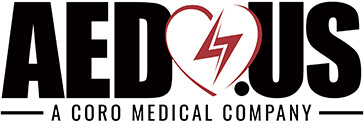- Sudden collapse
- No pulse
- No breathing
- Loss of consciousness
- Chest discomfort
- Weakness
- Palpitations
- Shortness of breath
- Call 911- If you have immediate access to a phone, call before starting CPR.
- Perform CPR- Quickly check for breathing. If the person isn’t breathing normally, begin CPR. Push hard and fast on the person’s chest at the rate of 100 to 120 compressions a minute (think “Staying Alive by the Bee Gees) If you’ve been trained in CPR and feel comfortable doing so, give 2 rescue breaths after every 30 compressions. If you haven’t been trained, just continue chest compressions. Allow the chest to rise completely between compressions. Keep doing this until an Automated External Defibrillator (AED) is available or help arrives.
- Use an Automated External Defibrillator (AED)- If there is an AED close by, use it! It will give step-by-step voice instructions. Continue chest compressions while the AED is charging. If advised, the device will deliver a shock and then immediately resume CPR, starting with chest compressions, or give chest compressions only, for about two minutes. Keep doing this until medical help arrives.
 Written by Blaire Czarniecki Customer Service Director
Written by Blaire Czarniecki Customer Service DirectorFact checked by Phillip Woods, BA, NREMT-P, FP-C
Blaire attended the University of Tennessee where she graduated with a Bachelor of Science in Human Ecology- Child and Family Studies. She has been in the Automated External Defibrillator (AED) industry for over eight years and is the Director of Customer Service for Coro Medical. Blaire is also an American Red Cross-certified CPR/AED/First Aid Instructor, highly trained by each manufacturer on their specific AEDs, and knowledgeable regarding ALL State AED regulations and legislation.
“I know that every day I come to work, I am playing a part in saving someone’s life. I am passionate about these devices and am always looking for new and innovative ways to spread awareness and knowledge about Sudden Cardiac Arrest (SCA). I look forward to the day when everywhere I go, I will see an AED—when SCA will no longer take any lives.”
Last updated October 17, 2019





